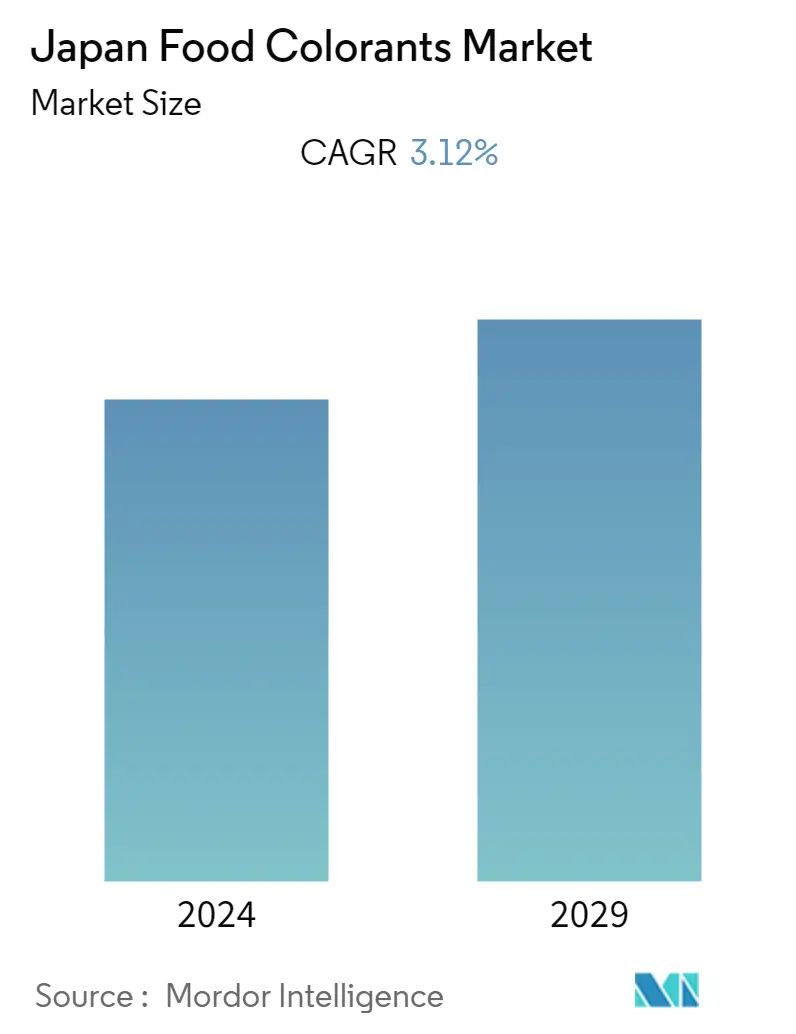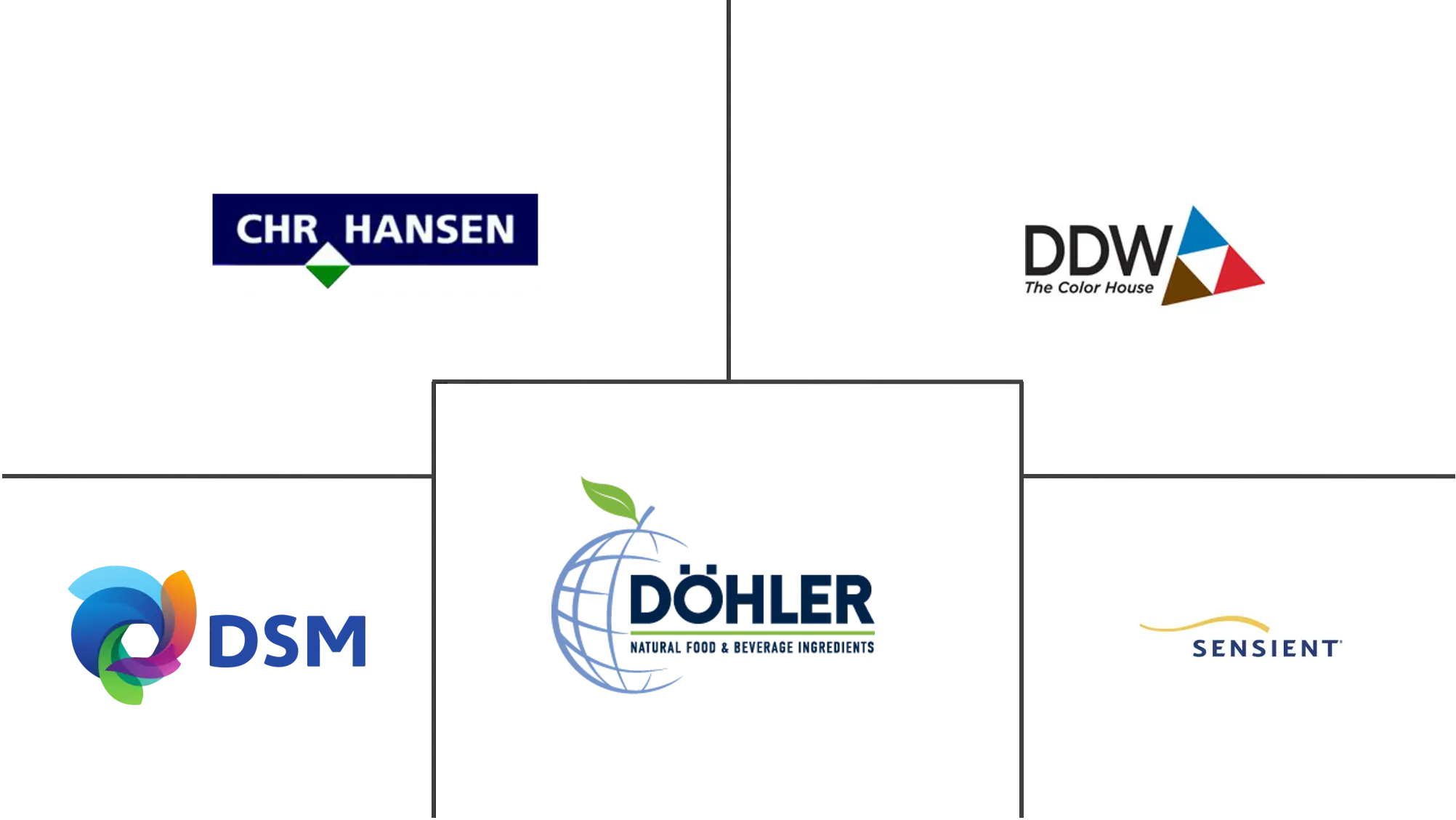Market Size of Japan Food Colorants Industry

| Study Period | 2019 - 2029 |
| Base Year For Estimation | 2023 |
| Forecast Data Period | 2024 - 2029 |
| Historical Data Period | 2019 - 2022 |
| CAGR | 3.12 % |
| Market Concentration | Low |
Major Players
*Disclaimer: Major Players sorted in no particular order |
Japan Food Colorants Market Analysis
The Japanese food colorants market is projected to record a CAGR of 3.12% during the forecast period (2020 - 2025).
- The motive to redeem the lost appeal of processed foods by presenting more appealing products to consumers has been favoring the market growth of the associated solutions, including food colorants.
- The increasing demand and consumer preference for minimally processed foods and health-promoting properties of natural colorants are estimated to drive the natural color segment of the market, with the growth rate being almost double, as compared to the synthetic color segment.
Japan Food Colorants Industry Segmentation
The Japanese food colorants market is segmented into natural color and synthetic color. The study also includes the revenue generated through beverages, dairy and frozen products, bakery, meat, poultry, and seafood, confectionery, oils and fats, and other applications.
| Type | |
| Natural Color | |
| Synthetic Color |
| Application | |
| Beverages | |
| Dairy and Frozen Products | |
| Bakery | |
| Meat, Poultry, and Seafood | |
| Confectionery | |
| Oils and Fats | |
| Other Applications |
Japan Food Colorants Market Size Summary
The Japanese food colorants market is experiencing a steady growth trajectory, driven by the increasing consumer demand for visually appealing processed foods. This demand is particularly influencing the natural colorants segment, which is gaining traction due to its health-promoting properties and consumer preference for minimally processed foods. While synthetic colorants currently dominate the market due to their cost-effectiveness and consistent application in the food industry, there is a noticeable shift towards natural ingredients. This shift is expected to impact the revenue distribution within the market, as consumers increasingly favor natural over synthetic options.
Beverages represent the largest segment within the Japanese food colorants market, fueled by a rising consumer preference for convenience foods and on-the-go beverage options. This trend has led to a surge in product innovations and launches, such as the introduction of a red-radish-derived food colorant by San-Ei-Gen, which addresses specific application needs without altering flavor. The market is characterized by a high level of fragmentation, with numerous regional and global players competing through strategic initiatives like product launches, partnerships, and acquisitions. Key players in the market include Chr. Hansen Holding AS, D.D. Williamson & Co., and Sensient Technologies Corporation, among others.
Japan Food Colorants Market Size - Table of Contents
-
1. MARKET DYNAMICS
-
1.1 Market Drivers
-
1.2 Market Restraints
-
1.3 Industry Attractiveness - Porter's Five Forces Analysis
-
1.3.1 Threat of New Entrants
-
1.3.2 Bargaining Power of Buyers/Consumers
-
1.3.3 Bargaining Power of Suppliers
-
1.3.4 Threat of Substitute Products
-
1.3.5 Intensity of Competitive Rivalry
-
-
-
2. MARKET SEGMENTATION
-
2.1 Type
-
2.1.1 Natural Color
-
2.1.2 Synthetic Color
-
-
2.2 Application
-
2.2.1 Beverages
-
2.2.2 Dairy and Frozen Products
-
2.2.3 Bakery
-
2.2.4 Meat, Poultry, and Seafood
-
2.2.5 Confectionery
-
2.2.6 Oils and Fats
-
2.2.7 Other Applications
-
-
Japan Food Colorants Market Size FAQs
What is the current Japan Food Colorants Market size?
The Japan Food Colorants Market is projected to register a CAGR of 3.12% during the forecast period (2024-2029)
Who are the key players in Japan Food Colorants Market?
Chr. Hansen Holding A/S, D.D. Williamson & Co, Sensient technologies Corporation , Koninklijke DSM N.V. and Dohler Group are the major companies operating in the Japan Food Colorants Market.

